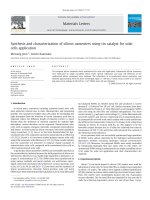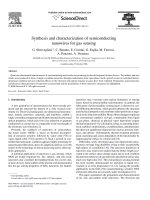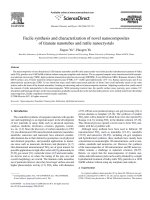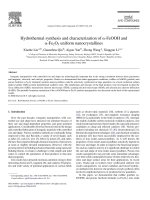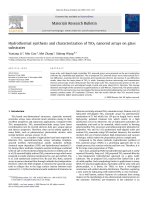synthesis and optimization of digital circuits
Bạn đang xem bản rút gọn của tài liệu. Xem và tải ngay bản đầy đủ của tài liệu tại đây (709.36 KB, 36 trang )
CEG790
Dr. Travis Doom
Wright State University
Computer Science and Engineering
Synthesis and Optimization
Synthesis and Optimization
of
of
Digital Circuits
Digital Circuits
CEG790
Outline
Outline
■ Introduction
–
Microelectronics
–
Micro “economics”
–
What is “design”?
■ Techniques for Digital Synthesis
–
Architectural-Level Synthesis
–
Logic-Level Synthesis
–
Geometric Synthesis
■ Techniques for Formal Verification
–
Automated Theorem-Provers
–
Graph-based Algorithms
■ Reengineering
CEG790
Overview: Microelectronics
Overview: Microelectronics
■ What is a microelectronic component?
–
Devices which exploit the properties of semiconductor materials
–
Constructed by patterning a substrate and locally modifying its
properties to shape “wires” and logical “devices”
–
Complex functions are “integrated” into one physical package
–
Fabrication is very complex
■ Microelectronic components enable “smart” systems
–
Prevalent in modern systems
–
Failures are not taken well - most applications are “critical”
CEG790
Overview: “Micro” Economics
Overview: “Micro” Economics
■ IC technology has progressed tremendously over 40 yrs.
–
Moore’s Law [SSI - ‘60, MSI - ‘70, VLSI - ‘90, ?? - ‘00]
■ Costs have increased tremendously as well
–
Larger capital investment due to cost of refining precision
–
Larger scale increases effort to achieve zero-defect design
●
ICs are nearly impossible to repair
●
The design must be correct (and manufacturing defects limited)
–
Design and manufacturing costs must be recovered via sales
●
Few designs do enjoy a high volume of sales or long life
●
Many systems require specialized devices (ASICs) - few hold a
significant market share individually
●
Improvement of technology causes immediate obsolescence
CEG790
Overview: “Micro” Economics
Overview: “Micro” Economics
■ How can costs be reduced and net profit increased?
–
Minimize Design (and test) time
●
Reduces both time-to-market and designers’ salaries
–
Increase quality of design to increase fabrication yield and provide
competitive performance
■ Design automation techniques provide an effective means
for designing economically viable products
–
Carrying out a full design w/o errors is increasingly difficult w/o
systematic techniques to handle data
–
CAD techniques tend to focus on Digital Synchronous circuits as
they represent the vast majority of circuits in the market
CEG790
Overview: What is “Design”?
Overview: What is “Design”?
■ General model for (Re-)Engineering
(Byrne, 1992)
Existing System Target System
Implementation
Design
Requirements Requirements
Con-
ceptual
Con-
ceptual
Design
Implementation
re-think
re-specify
re-design
re-build
Alteration
Reverse
Engineering
Abstraction
Forward
Engineering
Refinement
CEG790
Automated Synthesis
Automated Synthesis
■ Design Process
Register Transfer Level
Behavioral Level
Gate Level
Physical Design
high-level synthesis
logic synthesis
geometrical synthesis
~ Requirements Spec.
~ Implementation Spec.
CEG790
Automated Synthesis
Automated Synthesis
■ Design Process
Register Transfer Level
Behavioral Level
Gate Level
Physical Design
high-level synthesis
logic synthesis
geometrical synthesis
PC = PC + 1;
FETCH(PC);
DECODE(INST);
MULT
ADD
RAM
CONTROL
CEG790
High-level Synthesis
High-level Synthesis
■ High-level (Architectural-level) synthesis deals with the
transformation of an abstract model of behavior into a
model consisting of standard functional units
–
Goal: to construct the macroscopic structure of a circuit
–
Input: an abstract model of behavior
●
Common Abstract Models: HDLs, State diagrams, ASM charts,
Sequencing graphs or Control/Data-flow graphs.
–
Output: a structural view of the circuit, in particular of its datapath,
and a logic-level specification of its control unit
●
often referred to as the register-transfer level or macro-module model
CEG790
High-level Synthesis
High-level Synthesis
–
The data path is an interconnection of resources whose execution
and I/O is determined by the control unit according to a schedule
●
functional resources:
–
Primitive resources: “stock” functions
–
Application-specific resources: requires model
●
memory resources: registers
or
memory arrays
to store data
●
interface resources:
steering logic circuits (e.g., muxes and buses)
that send data to the appropriate destination at the appropriate time
Control Unit Datapath
Control Signals
Status Signals
Control
Outputs
Data
Inputs
Control
Inputs
Data
Outputs
CEG790
High-level Synthesis
High-level Synthesis
■ Measuring cost
–
Evaluation Metrics: area, cycle-time (clock period), latency, and
throughput (pipelines)
–
The objectives form a n-dimensional
design space
●
Architectural exploration
is the traversal of the design space to
provide a spectrum of solutions for the designers selection
●
Generally only the resources are considered
(resource dominant)
■
The fundamental architectural synthesis problem
–
Explore the design space to minimize “cost” given:
●
A circuit model (behavioral)
●
A set of constraints (on cost)
●
A set of functional resources (characterized for area, delay, etc.)
CEG790
Temporal Scheduling
Temporal Scheduling
■ Automated approaches to the fundamental problem consist
of two related constrained optimization problems:
Temporal Scheduling and Spatial Binding
■ Temporal Scheduling
–
Each architectural-level operation is reduced to resource operations
and the time interval for the operation execution determined
●
A graph of resources must be created such that one path from start to
end exists to perform each operation (in parallel)
●
The length of the path represents the operation latency
●
Constraints include maximum latency, bounds on the resource usage
per type, etc.
CEG790
Scheduled Sequencing Graph
Scheduled Sequencing Graph
■ BDDs
*
*
*
+
>
>
*
T
0
T
1
T
2
NOP
* +
* > + +
NOP
T
3
T
4
T
5
Constraints:
Maximum Latency: 5
*: 3 max
+: 3 max
>: 3 max
CEG790
Spatial Binding
Spatial Binding
■ Spatial Binding
–
Determining the detailed interconnections of the data path and the
logic-level specifications of the control unit
●
The scheduled sequencing graph represents all necessary operations
●
Each resource may cover several operations (for example, an ALU
covers addition, subtraction, comparison, etc.)
●
A simple case is dedicated resource binding - each operation is bound
to one resource
●
In general, we wish to share a resources - we don’t need to replicate
beyond the maximum number of resources at any given temporal
depth
●
In essence, this becomes a set-covering problem (NPC)
■
Once a set of resources is identified, area and performance
estimations can be calculated from model data
CEG790
Scheduled Sequencing Graph w/Resource Binding
Scheduled Sequencing Graph w/Resource Binding
■ BDDs
*
*
*
+
>
>
*
T
0
T
1
T
2
NOP
* +
* > + +
NOP
T
3
T
4
T
5
CEG790
Automated Synthesis
Automated Synthesis
■ Design Process
Register Transfer Level
Behavioral Level
Gate Level
Physical Design
high-level synthesis
logic synthesis
geometrical synthesis
MULT
ADD
RAM
CONTROL
D D
+
CEG790
Logic-level Synthesis
Logic-level Synthesis
■ Logic-level synthesis deals with the transformation of an
macroscopic model to an interconnection of logic
primitives
–
These primitives determine the microscopic (i.e., gate-level)
structure of the circuit
■ A basic approach is to replace “stock” modules with pre-
optimized “stock” logic-level representations
–
Local optimizations of do not necessarily create an optimal result
–
Cost is increased (area, latency, power) / decreased (design time)
■ Alternatively, the modules are partitioned into manageable
designs (generally straightforward for the data path)
–
Several different types of finite-state machine decompositions exist
CEG790
Logic-level Synthesis Tasks
Logic-level Synthesis Tasks
■ Optimize finite-state machines by state minimization
–
Stated as a bi-partite covering problem
■ Select a state encoding (for control unit)
–
Heuristics include one-hot, almost one-hot, minimal-bit change,
prioritized-adjacency, etc.
■ Minimize the related combinational component
–
Two-level (SOP) minimization (Quine-McCluksey, Rudell-
Sangiovanni, and McGeer algorithms)
–
Multi-level minimization (Decomposition is non-trivial)
■ Cell-library binding
–
Implement minimized combinational functions as an
interconnection of devices that are available in a given technology
library (a bound network)
CEG790
Automated Synthesis
Automated Synthesis
Register Transfer Level
Behavioral Level
Gate Level
Physical Design
high-level synthesis
logic synthesis
geometrical synthesis
D D
+
CEG790
Geometrical-level Synthesis
Geometrical-level Synthesis
■ Geometrical-level synthesis (physical design) consists of
creating a physical view at the geometric level
–
It entails the specification of all geometric patterns defining the
physical layout of the chip, as well as their position
CEG790
Validation and Verification
Validation and Verification
■ Design Process
Register Transfer Level
Behavioral Level
Gate Level
Physical Design
high-level synthesis
logic synthesis
geometrical synthesis
D D
+
MULT
ADD
RAM
CONTROL
PC = PC + 1;
FETCH(PC);
DECODE(INST);
?
CEG790
Validation and Verification
Validation and Verification
■ Design Process
Register Transfer Level
Behavioral Level
Gate Level
Physical Design
high-level synthesis
logic synthesis
geometrical synthesis
V
e
r
i
f
i
c
a
t
i
o
n
compilation
compilation
simulation
simulation
compilation
simulation
CEG790
Validation and Verification
Validation and Verification
■ Circuit validation consists of acquiring reasonable
certainty that a circuit will function correctly
–
Assume no manufacturing fault is present
–
Can be performed via simulation or via verification
■ Simulation (Traditional Validation)
–
Traditional verification consists of analyzing circuit variables (at
different levels) over an interval of time
●
Unless exhaustive, simulation does not provide full coverage
■ Formal Verification (Design Verification)
–
Verification methods mathematically prove or disprove the
consistency between two models, or a model and some set of
circuit model properties
●
Requires a suitable representation system
●
Proofs must be mechanizable
CEG790
Formal Verification
Formal Verification
■ Property Testing (Testing via partial specification)
–
Safety properties: verify “bad things will never occur”
●
ex: for every path in the future, at every node on the path, if the
Request signal is low, it remain lows until Acknowledge goes low
–
Liveness properties: verify “good things will occur”
●
ex: for every path in the future, if there has been a Request signal,
then eventually there will be an Acknowledge signal in response to
the request on at least one node on the path
■ Popular FV approaches include:
–
Theorem Proving
–
Symbolic Model Checking
–
Recursive Learning
–
many graph-based approaches (BDDs, etc.)
CEG790
Automated Theorem-
Automated Theorem-
Provers
Provers
■ Automated Theorem-Proving techniques require:
–
A representation of the model and/or properties as a series of
formulas (axioms) in a High-Order Language
–
A finite collection of rules of inference
■ By means of a rule of inference a new formula can be
derived from a given finite set of formulas
–
A formal proof is a finite sequence of formulas, each member of
which is either an axiom or the outcome of apply a rule of
inference to previous members of the sequence
–
The last formal proof is the theorem
■ Allows exhaustive (heuristic directed) search for proof
–
Theorem-provers presently require extensive user intervention


